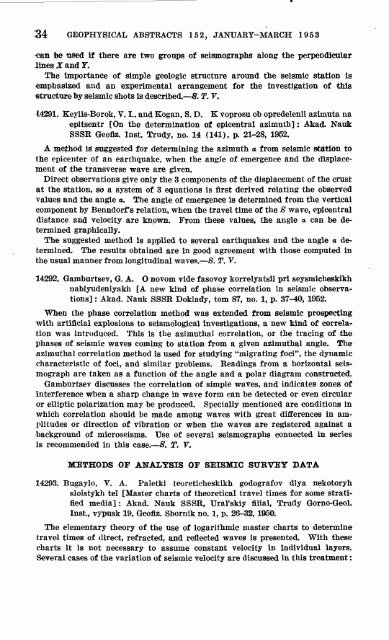Geophysical Abstracts 152 January-March 1953
Geophysical Abstracts 152 January-March 1953
Geophysical Abstracts 152 January-March 1953
You also want an ePaper? Increase the reach of your titles
YUMPU automatically turns print PDFs into web optimized ePapers that Google loves.
34 GEOPHYSICAL ABSTRACTS <strong>152</strong>, JANUARY-MARCH <strong>1953</strong><br />
can be used if there are two groups of seismographs along the perpendicular<br />
lines X and F.<br />
The importance of simple geologic structure around the seismic station is<br />
emphasized and an experimental arrangement for the investigation of this<br />
structure by seismic shots is described. 8. T. V.<br />
14291. Keylis-Borok, V. I., and Kogan, S. D. K voprosu ob opredelenii azimuta na<br />
epitsentr [On the determination of epicentral azimuth]: Akad. Nauk<br />
SSSR Geofiz. Inst. Trudy, no. 14 (141), p. 21-28, 1952.<br />
A mesthod ig suggested for determining the azimuth a from seismic s>Mtibn to<br />
the epicenter of an earthquake, when the angle of emergence and the displace<br />
ment of the transverse wave are given.<br />
Direct observations give only the 3 components of the displacement of the crust<br />
at the station, so a system of 3 equations is first derived relating the observed<br />
values and the angle a. The angle of emergence is determined from the vertical<br />
component by Benndorf's relation, when the travel time of the 8 wave, epicentral<br />
distance and velocity are known. From these values, the angle a can be de<br />
termined graphically.<br />
The suggested method is applied to several earthquakes and the angle a de<br />
termined. The results obtained are in good agreement with those computed in<br />
the usual manner from longitudinal waves. S. T. V.<br />
14292. Gamburtsev, G. A. O novom vide fasovoy korrelyatsii pri seysmicheSkikh<br />
nablyudeniyakh [A new kind of phase correlation in seismic observa<br />
tions] : Akad. Nauk SSSR Doklady, torn 87, no. 1, p. 37-40, 1952.<br />
When the phase correlation method was extended from seismic prospecting<br />
with artificial explosions to seismological investigations, a new kind of correla<br />
tion was introduced. This is the azimuthal correlation, or the tracing of the<br />
phases of seismic waves coming to station from a given azimuthal angle. The<br />
azimuthal correlation method is used for studying "migrating foci", the dynamic<br />
characteristic of foci, and similar problems. Readings from a horizontal seis<br />
mograph are taken as a function of the angle and a polar diagram constructed.<br />
Gamburtsev discusses the correlation of simple waves, and indicates zones of<br />
interference when a sharp change in wave form can be detected or even circular<br />
or elliptic polarization may be produced. Specially mentioned are conditions in<br />
which correlation should be made among waves with great differences in am<br />
plitudes or direction of vibration or when the waves are registered against a<br />
background of microseisms. Use of several seismographs connected in series<br />
is recommended in this case. S. T. V.<br />
METHODS OF ANALYSIS OF SEISMIC SUBVEY DATA<br />
14293. Bugaylo, V. A. Paletki teoreticheskikh godografov dlya nekotoryh<br />
sloistykh tel [Master charts of theoretical travel times for some strati<br />
fied media]: Akad. Nauk SSSR, Ural'skiy filial, Trudy Gorno-Geol.<br />
Inst., vypusk 19, Geofiz. Sbornik no. 1, p. 26-32, 1950.<br />
The elementary theory of the use of logarithmic master charts to determine<br />
travel times of direct, refracted, and reflected waves is presented. With these<br />
charts it is not necessary to assume constant velocity in individual layers.<br />
Several cases of the variation of seismic velocity are discussed in this treatment:

















